Cargo Ship Takes out Trash; Crew Works on Cygnus Preps and Science Hardware

A Russian cargo ship left the International Space Station this morning and was deorbited for a destructive demise over the Pacific Ocean. The Expedition 58 crew now turns its attention to the departure of a U.S. space freighter next month.
The Progress 70 (70P) resupply ship ended its six-and-a-half month stay at the station when it undocked from Pirs docking compartment today at 7:55 a.m. EST. It descended into Earth’s atmosphere less than four hours later loaded with trash and discarded gear and burned up safely over the southern Pacific.
Northrop Grumman’s Cygnus commercial cargo vessel is next up, scheduled to depart the Unity module in early February. Astronauts Anne McClain and David Saint-Jacques have been reviewing Cygnus departure procedures and carefully packing the spaceship throughout the week.
McClain and Saint-Jacques spent Friday working on a variety of science hardware and life support gear aboard the orbital lab. The duo first set up gear to measure airflow inside Japan’s Kibo laboratory module. Next, they serviced a pair of science freezers nicknamed MELFI and GLACIER that store research samples at ultra-cold temperatures.
NASA’s McClain also replaced hardware in the Actiwatch Spectrum, a wearable device that analyzes an astronaut’s sleep quality, sleep onset, hyperactivity and other daily routines. Saint-Jacques from the Canadian Space Agency activated a new 3D printer known as the Refabricator that uses recycled plastics.
Commander Oleg Kononenko from Roscosmos monitored this morning’s 70P undocking and photographed the departing spacecraft. The station veteran also checked on Russian laptop computers and participated in a study that explores how cosmonauts adapt to complex space tasks.
Russian Cargo Ship Undocks; U.S. Cygnus Leaves in February
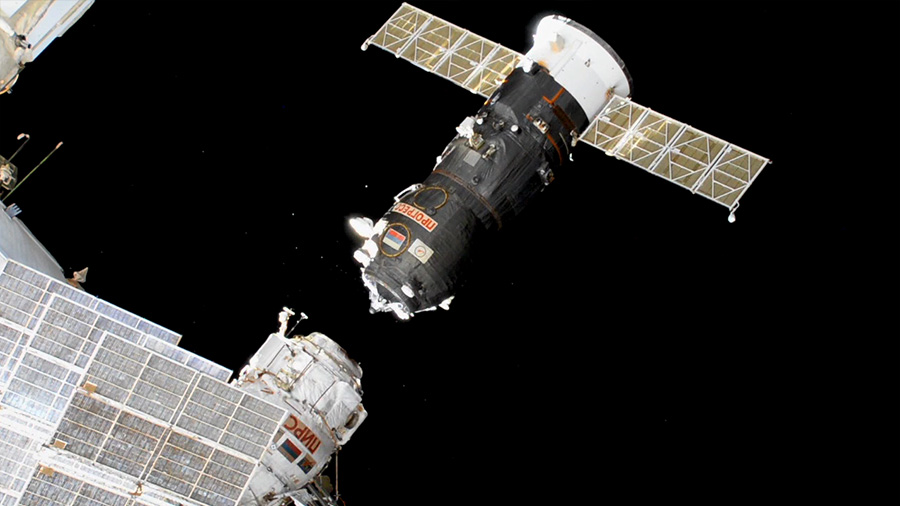
A Russian Progress 70 (70P) cargo craft undocked from the International Space Station today at 7:55 a.m. EST loaded with trash and discarded gear. It will orbit Earth a few more hours before reentering the Earth’s atmosphere over the Pacific Ocean for a fiery but safe destruction.
The Progress delivered three tons of food, fuel and supplies to the station crew members on July 9. It was the first two-orbit rendezvous in International Space Station history.
Today’s departure leaves three spaceships attached to the orbital lab including Northrop Grumman’s Cygnus space freighter and Russia’s Progress 71 resupply ship and Soyuz MS-11 crew ship. Cygnus is due to complete its mission when it departs from the station’s Unity module on Feb. 8.
BEAM Stowage, Medical Procedures Review and Commercial Crew Update
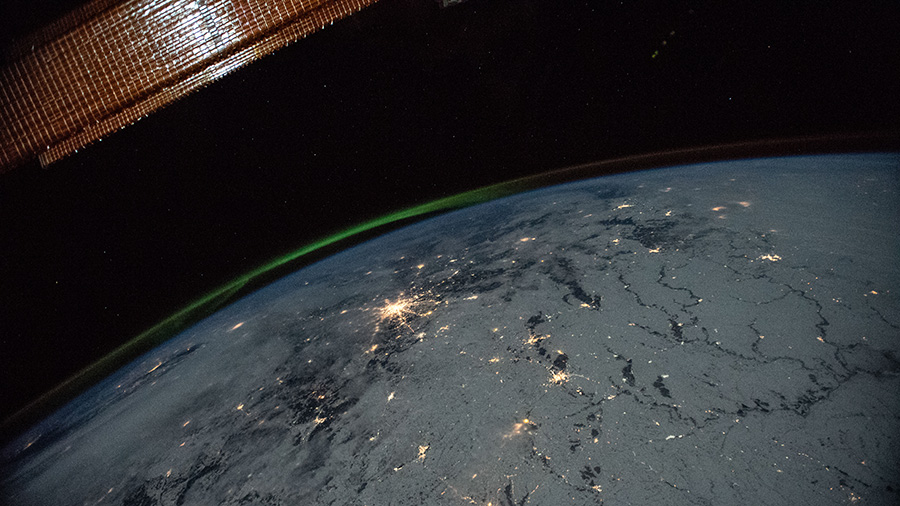
The Expedition 58 crew opened up the International Space Station’s “closet” today stowing hardware inside the experimental module. The three orbital residents also reviewed medical emergency procedures and NASA’s Commercial Crew Program announced a crew update Tuesday.
The Bigelow Experimental Activity Module (BEAM) had its stay extended at the orbital lab in November of 2017. BEAM now serves as a cargo hold and continues to undergo tests of its ability to withstand the rigors of microgravity. Crews periodically check BEAM’s sensors to determine its ongoing suitability for spaceflight.
Astronauts Anne McClain and David Saint-Jacques entered BEAM today stowing a variety of station hardware inside the near three-year-old module. The added volume at the station enables more room for advanced space research at the orbital complex.
They later joined Commander Oleg Kononenko in the afternoon and reviewed procedures in the event a crew member experiences a medical emergency in space. Actions a crew can take if necessary include cardiopulmonary resuscitation, surgical procedures aboard the orbital lab or quickly returning an affected astronaut to Earth aboard the Soyuz spacecraft.
The Commercial Crew Program announced a crew change Tuesday afternoon with NASA astronaut Michael Fincke replacing NASA astronaut Eric Boe. Fincke now begins his training as a crew member for Boeing’s CST-100 Starliner Crew Flight Test. Boe will now become assistant chief of the commercial crew office at Johnson Space Center in Houston.
Astronaut Health Study and Spacesuit Work Onboard Station
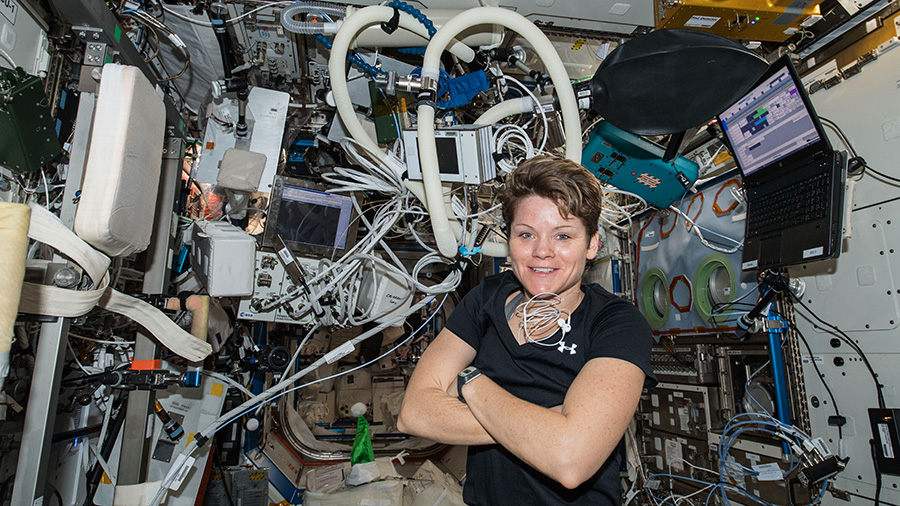
The three Expedition 58 crew members continued studying today the upward flow of fluids inside astronauts’ bodies caused by living in space. The crew also worked on packing a U.S. cargo craft and servicing U.S. spacesuits at the International Space Station.
One easily recognizable symptom of living in space is the “puffy face” astronauts get due to the upward flow of fluids in the body. Underlying impacts of this phenomenon include head and eye pressure changes that occur off Earth which the Fluid Shiftsexperiment is seeking to better understand.
All three crew members gathered in the Zvezda service modulethroughout the day using a special suit to temporarily reverse these upward fluid shifts. NASA astronaut Anne McClain wore the Lower Body Negative Pressure suit, which pull fluids downward, while Flight Engineer David Saint-Jacques checked her head and eye pressure using a variety of biomedical devices. Commander Oleg Kononenko assisted the duo with guidance from specialists on the ground.
McClain and Saint-Jacques also partnered up before lunchtime to get the Cygnus resupply ship ready for its departure on Feb. 12. The duo reviewed packing procedures and stowed inventory aboard the U.S. space freighter from Northrop Grumman.
McClain started the day installing the new Facet Cell crystal growth experiment in the Kibo laboratory module. She spent the rest of the afternoon cleaning cooling loops on U.S. spacesuits in the Quest airlock as NASA prepares for spacewalks at the orbital lab later this year.
Tech Work and Life Science Ahead of Orbital Boost Today
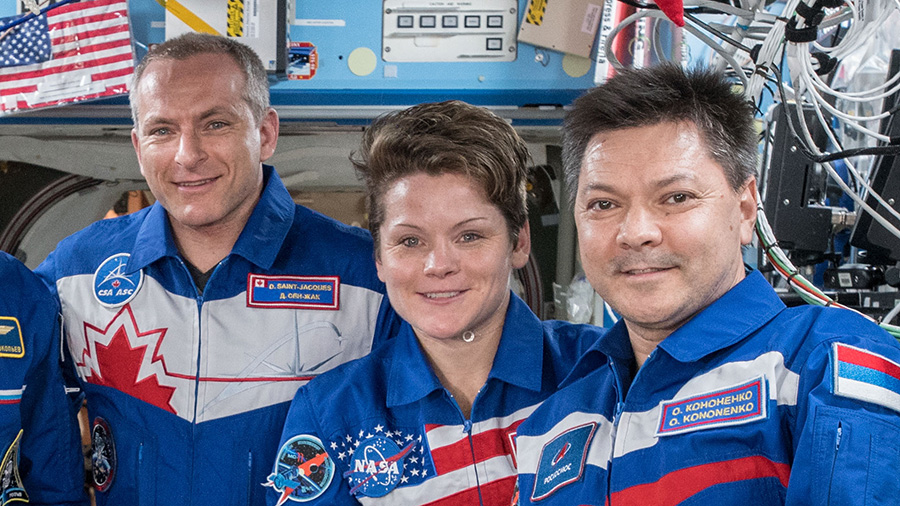
Satellite and combustion technology are being worked on today aboard the International Space Station. The Expedition 58 crew also studied botany and psychology while the station raised its orbit in a planned reboost maneuver.
Anne McClain of NASA installed new SlingShot small satellite deployer gear inside the Cygnus space freighter. SlingShot will deploy small research satellites from Cygnus after it departs the space station’s Unity module in February and reaches a safe distance.
McClain also transferred biomedical hardware for the Fluid Shiftshead and eye pressure study into the Zvezda service module for continuing research. She later worked in the Columbus lab moduleinstalling a light meter to measure the amount of light nourishing plants inside the Veggie botany facility.
Canadian Space Agency astronaut David Saint-Jacques opened up the Combustion Integrated Rack and configured hardware inside the flame and soot research device. The work is being done ahead of operations for the Advanced Combustion in Microgravity Experiments that encompass a set of five independent gaseous flames studies.
He later typed his mood, thoughts and emotions into an electronic journal for the Behavioral Core Measures experiment. The psychological study seeks to understand how the spacecraft environment, long-term separation from family and friends, loss of day-night cycle and other factors impact crew behavior.
In the Russian segment of the station, Commander Oleg Kononenko transferred fluids and packed trash into the docked Progress 70 (70P) cargo craft. The Progress resupply ship is due to undock from the Pirs docking compartment on Jan. 25.
A second docked Progress cargo craft, the 71P, fired its engines shortly after 1:01 p.m. EST to raise the station’s orbit. The reboost comes in advance of upcoming cargo missions and the next crew launch in February.
Crew Studies Space-Caused Eye Pressure and Cultural Differences

The Expedition 58 crew focused again today on studying head and eye pressure changes astronauts experience while living in space. The crew then went on to more science hardware and life support maintenance aboard the International Space Station.
Flight Engineers Anne McClain and David Saint-Jacques worked throughout Thursday morning researching the upward flow of fluids that occurs inside astronauts’ bodies. The duo conducted eye scans with a variety of devices to measure eye pressure changes caused by these fluid shifts in microgravity.
McClain then spent the afternoon connecting cables and installing parts on the Multi-Purpose Small Payload Rack (MSPR) that houses small experiments in the Kibo lab module. Saint-Jacques replaced electronics gear in the Kubik incubator that enables research on seeds, cells and small animals in the Columbus lab module.
Commander Oleg Kononenko ensured the upkeep of life support gear and other station systems in the Russian segment of the orbital lab. The veteran cosmonaut of three previous Expeditions ended the day exploring how station crew members from around the world interact and learn to live together in space.
Astronauts Study Head and Eye Pressure, Wearable Body Monitor

Human research took precedence aboard the International Space Station today as the Expedition 58 crew explored how astronauts adapt to living in space. The orbital residents also performed more ordinary roles as computer technicians and plumbers.
NASA astronaut Anne McClain is studying today the fluid shiftsfrom an astronaut’s lower body to the upper body and how they pressure the head and eyes during a spaceflight. She collected her blood samples for the long-running experiment, spinning them in a centrifuge before stowing the samples in a science freezer.
Flight Engineer David Saint-Jacques measured his blood pressure beginning operations with the new Bio-Monitor system from the Canadian Space Agency. The wearable device monitors an astronaut’s physiological data in real-time with minimum interference to crew activities.
McClain also had time to relocate and deploy a laptop computer from the Harmony module to the Columbus lab module. Saint-Jacques spent the rest of Wednesday afternoon replacing parts in the space station’s toilet located in the Tranquility module.
Commander Oleg Kononenko worked on Russian maintenance in the orbital lab before inspecting and photographing windows in the Russian modules. He wrapped up the day on a pair of ongoing Earth observation studies photographing natural and man-made phenomena.
Station Trio Practices Emergency Before Radiation, Physics Research
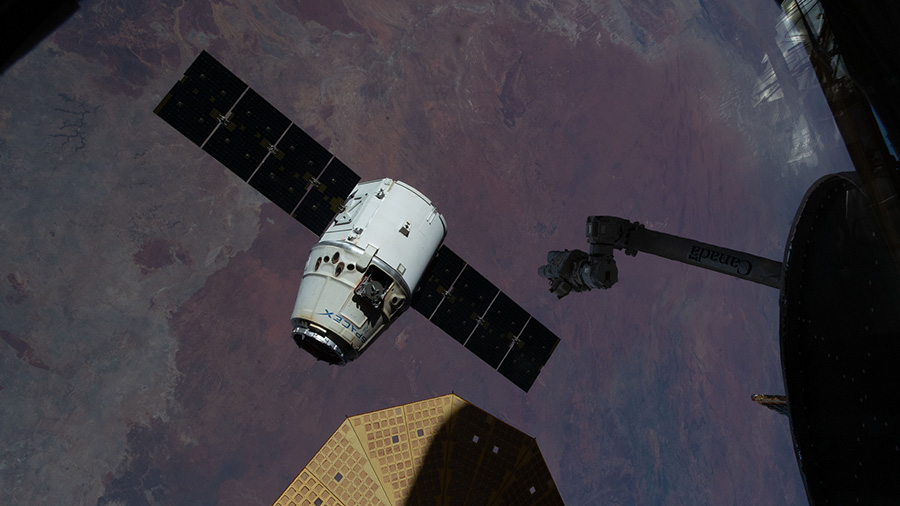
The Expedition 58 crew members started Tuesday with an emergency drill before splitting up for more space research and hardware maintenance.
Commander Oleg Kononenko led Flight Engineers Anne McClainand David Saint-Jacques through a simulated emergency this morning aboard the International Space Station. The trio practiced communication and coordination with Mission Control Centers in Houston and Moscow.
The unlikely emergency scenarios the crew trains for include events such as depressurization, ammonia leaks and fires. Responses include quickly donning safety gear, closing a module hatch to isolate pressure and ammonia leaks, extinguishing a fire and evacuating the station aboard the Soyuz crew ship.
McClain then moved on to cable and parts work on the Multi-Purpose Small Payload Rack (MSPR) that can house a variety of smaller experiments. She wrapped up the day photographing Saint-Jacques as he installed neutron detectors for an experiment to understand how space radiation impacts astronauts.
Kononenko worked today on the Electromagnetic Levitator that exposes materials to extremely high temperatures to explore their thermo-physical properties in the microgravity environment. The four-time station cosmonaut later went on to routine maintenance on life support systems in the orbital lab’s Russian segment.
Dragon Back on Earth as Crew Revs Up Station Science

The SpaceX Dragon cargo craft is back on Earth after splashing down in the Pacific Ocean Sunday night loaded with critical space research and International Space Station hardware. Four spaceships remain parked at the orbital lab including Northrop Grumman’s Cygnus resupply ship from the United States.
Today, the three-member Expedition 58 crew is exploring a wide array of microgravity science to improve life for humans on Earth and in space. The orbital residents also worked on life support systems and upgraded computer hardware.
NASA astronaut Anne McClain set up a specialized microscope in the morning for the Biophysics-5 study to research the production of protein crystals. Afterward, she deactivated Dragon communications gear then swapped out hard drives on several laptop computers.
Flight Engineer David Saint-Jacques of the Canadian Space Agency opened up the Combustion Integrated Rack and replaced optics gear inside the flame and soot research device. He later swapped a hydrogen sensor inside the Oxygen Generation System before inspecting and cleaning some of its parts.
A pair of tiny internal satellites, better known as SPHERES, were set up by Commander Oleg Kononenko today inside the Kibolaboratory module. High school students write algorithms and submit them in a competition to control the SPHERES to demonstrate spacecraft maneuvers and formation-flying for future space missions.
Dragon Released to Return Science and Supplies Back to Earth
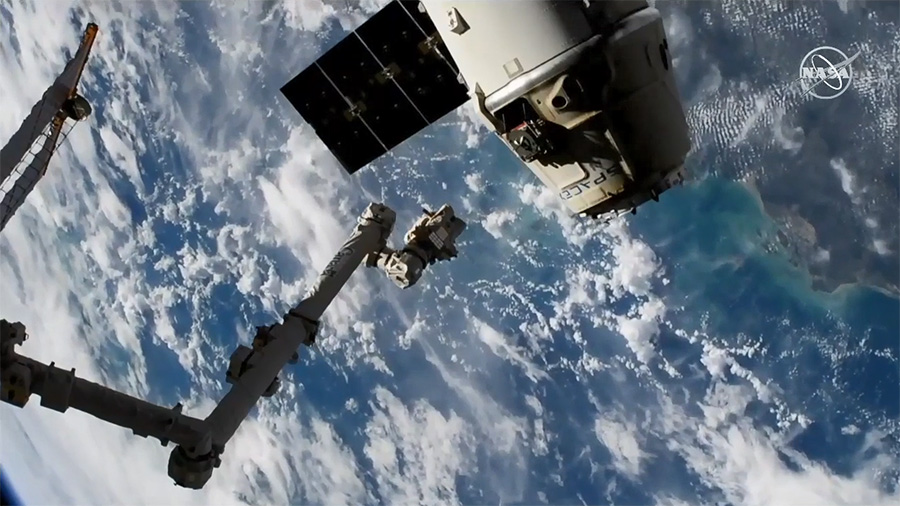
The SpaceX Dragon cargo craft was released from the International Space Station today at 6:33 p.m. EST. Robotics controllers remotely commanded the Canadarm2 robotic arm to let go of the U.S. space freighter sending it on a solo trajectory back to Earth.
Astronaut Anne McClain monitored the activities from the cupola and watched Dragon perform a series of departure burns as it separated itself to a safe distance from the orbital lab. Integrated operations between mission controllers in Houston and SpaceX controllers in California stop when Dragon reaches a point about one kilometer away from the station.
SpaceX personnel will retrieve Dragon after it parachutes to a splashdown in the Pacific Ocean Monday at 12:15 a.m. (9:15 p.m. Sunday Pacific time) then tow it to port in southern California. This will be the first nighttime splashdown and recovery for the Dragon with plenty of moonlight to track its entry.
The commercial cargo vessel is taking home a variety of critical space research that will immediately be picked up by NASAengineers and distributed to scientists across the nation. Station hardware will also be extracted for analysis, refurbishment or discarding.
Dragon completes a 36-day mission attached to the station’s Harmony module after delivering more than 5,600 pounds of science and supplies on Dec. 8. Today’s departure leaves four spacecraft, including Northrop Grumman’s Cygnus cargo craft, attached to the space station.
The next Dragon mission to the space station will be its first uncrewed demonstration mission designated SpaceX DM-1. The Commercial Crew Program’s first launch is currently targeted for February and will demonstrate ground systems, orbit to docking activities and landing operations.

my name is Promise dickson Finch am from Texas USA. I want to share a testimony of how Dr. OLU herbal mixture cream saves me from shame and disgrace, my penis was a big problem to me as the size was really so embarrassing,and i was also having weak erection problem. I can make love to my wife and my penis was just too small a full grown man like me having 4 inches penis and to worsen it i don't last in sex i cant even last two minutes it was really a thing of shame to me. My wife was really tired of me because my sex life was very poor,she never enjoyed sex,i was always thinking and searching for solutions everywhere until when i saw a testimony of how Dr. OLU. herbal mixture cream have been helping people regarding their sex life, so i decided to give him a try and to my greatest surprise in less than two weeks of taking the herbs my penis grow to 8 inches i couldn't believe my eyes and as i speak now my penis is now 8 inches and i do not have weak erection again. I can make love to my wife longer in bed. And my marriage is now stable,my wife now enjoy me very well in bed. You can contact him via (drolusolutionhome@gmail.com) You can contact him today and get your problem solved.Call +2348140654426 .." or you can also contact him through his what-app +238140654426
ReplyDelete